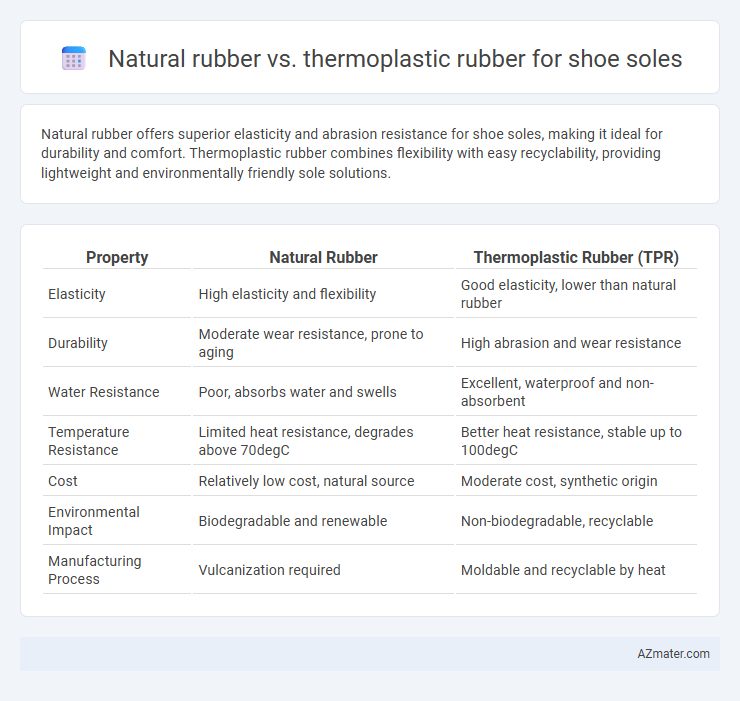Natural rubber offers superior elasticity and abrasion resistance for shoe soles, making it ideal for durability and comfort. Thermoplastic rubber combines flexibility with easy recyclability, providing lightweight and environmentally friendly sole solutions.
Table of Comparison
| Property | Natural Rubber | Thermoplastic Rubber (TPR) |
|---|---|---|
| Elasticity | High elasticity and flexibility | Good elasticity, lower than natural rubber |
| Durability | Moderate wear resistance, prone to aging | High abrasion and wear resistance |
| Water Resistance | Poor, absorbs water and swells | Excellent, waterproof and non-absorbent |
| Temperature Resistance | Limited heat resistance, degrades above 70degC | Better heat resistance, stable up to 100degC |
| Cost | Relatively low cost, natural source | Moderate cost, synthetic origin |
| Environmental Impact | Biodegradable and renewable | Non-biodegradable, recyclable |
| Manufacturing Process | Vulcanization required | Moldable and recyclable by heat |
Introduction to Shoe Sole Materials
Natural rubber offers excellent elasticity, abrasion resistance, and cushioning, making it a popular choice for durable and comfortable shoe soles. Thermoplastic rubber (TPR) combines the flexibility of rubber with the processability of plastics, providing lightweight, slip-resistant, and recyclable soles. Selection between natural rubber and TPR depends on performance requirements, cost, and environmental considerations for specific footwear applications.
What is Natural Rubber?
Natural rubber, derived from the latex sap of the Hevea brasiliensis tree, offers excellent elasticity, resilience, and abrasion resistance, making it a preferred material for durable shoe soles. It features superior traction and flexibility due to its molecular structure of long polymer chains, enhancing comfort and performance in footwear applications. Compared to thermoplastic rubber, natural rubber provides better biodegradability and environmental sustainability but may require treatment to improve heat and oil resistance.
What is Thermoplastic Rubber?
Thermoplastic rubber (TPR) is a versatile material combining the elasticity of rubber with the recyclability and processing ease of plastics, making it ideal for shoe soles requiring flexibility and durability. Unlike natural rubber, TPR can be melted and reshaped multiple times without degrading, enabling efficient manufacturing and customization of soles for various footwear styles. Its resistance to abrasion, oils, and weather also makes TPR a preferred choice for long-lasting, comfortable shoe soles in diverse environments.
Key Differences in Material Properties
Natural rubber offers superior elasticity and abrasion resistance, making it ideal for durable shoe soles that require flexibility and high traction. Thermoplastic rubber (TPR) provides enhanced chemical resistance and easier processing due to its thermoplastic nature, allowing for efficient molding and recyclability. Key differences lie in natural rubber's biodegradability and resilience versus TPR's thermal stability and customization options in shoe sole manufacturing.
Durability: Natural Rubber vs Thermoplastic Rubber
Natural rubber offers excellent abrasion resistance and resilience, making it highly durable for shoe soles in demanding conditions. Thermoplastic rubber, while providing good flexibility and ease of molding, generally exhibits lower wear resistance and may degrade faster under prolonged friction or harsh environments. Choosing natural rubber enhances longevity in heavy-use footwear, whereas thermoplastic rubber suits lighter, fashion-oriented applications with less emphasis on extreme durability.
Comfort and Flexibility Comparison
Natural rubber offers superior elasticity and cushioning, providing excellent comfort and shock absorption for shoe soles. Thermoplastic rubber combines flexibility with durability, maintaining shape under stress while allowing moderate movement and comfort. Natural rubber's resilience makes it ideal for dynamic activities, whereas thermoplastic rubber suits applications requiring consistent flexibility and wear resistance.
Traction and Grip Performance
Natural rubber offers superior traction due to its high elasticity and natural tackiness, making it ideal for shoe soles requiring excellent grip on wet or slippery surfaces. Thermoplastic rubber combines flexibility and durability with enhanced abrasion resistance, providing consistent grip performance across a wider range of temperatures and environments. Choosing between the two often depends on the specific traction demands and durability requirements of the shoe sole application.
Environmental Impact and Sustainability
Natural rubber offers superior biodegradability and renewable sourcing compared to thermoplastic rubber, which relies on petroleum-based materials with limited recyclability. The cultivation of natural rubber supports carbon sequestration and soil health, whereas thermoplastic rubber production contributes to higher greenhouse gas emissions and microplastic pollution. Choosing natural rubber for shoe soles aligns with sustainable manufacturing practices by reducing landfill waste and promoting circular economy principles.
Cost Considerations for Manufacturers
Natural rubber offers lower raw material costs due to its abundant availability and renewable sourcing, making it a cost-effective option for shoe sole production. Thermoplastic rubber (TPR) involves higher initial expenses because of complex processing requirements and the need for specialized machinery. Manufacturers must balance the durability and flexibility of TPR against the budget advantages of natural rubber when deciding on sole materials.
Which Shoe Sole Material is Best?
Natural rubber offers excellent elasticity, abrasion resistance, and superior grip, making it ideal for durable, high-performance shoe soles. Thermoplastic rubber (TPR) provides greater flexibility, lightweight comfort, and enhanced weather resistance, often preferred for casual and sporty footwear. Choosing the best shoe sole material depends on the specific requirements of durability, comfort, and environmental exposure.

Infographic: Natural rubber vs Thermoplastic rubber for Shoe sole
 azmater.com
azmater.com